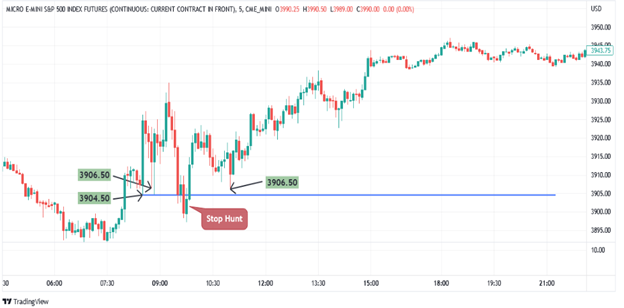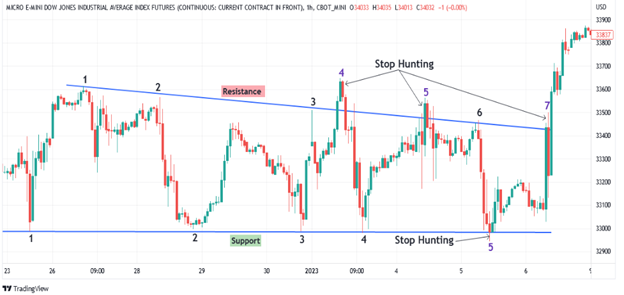
Understanding Stop Loss Hunting and Strategies to Avoid It
What is Stop-Loss Hunting?
Stop loss hunting, also known as stop hunting, is a trading strategy that intentionally triggers other traders’ stop losses to generate profits. Although this is a tactic that traders should be cautious of, it can also be used to a trader’s advantage with the right strategy.
The example of how it works:
Trader A purchases an asset at $22 and sets a stop-loss at $20. Trader B suspects that other traders, like Trader A, have set their stop-loss at $20 and aims to capitalize on this. Thus, Trader B places a sell stop around $20. If the market moves in Trader B’s favor, it hits the $20 level, triggering the stop-loss of Trader A and other traders who have placed a stop at that level. As a result, the prices drop rapidly below $20. Trader B takes advantage of this opportunity by opening a position and quickly closing it at a profit.
Should Stop Hunting be Considered Unethical?
While some traders may consider stop hunting to be unethical or predatory, regulatory bodies such as the CFTC have specific rules in place to prevent this practice by large institutions. Institutional traders have the financial resources to manipulate markets and move prices, which puts smaller retail traders at a disadvantage.
However, certain market levels may attract a cluster of stop-loss orders, creating opportunities for traders who can take advantage of the market flow without moving it. Unlike institutional traders, these smaller traders would not be manipulating markets but rather profiting from the natural movement of the market as stop-losses are triggered by market shifts.
How Can You Find for Stop-Losses?
The technique of stop-loss hunting involves identifying potential levels where many stop-loss orders may be concentrated. Traders may use different strategies to attempt stop hunting, which can include:
-
Key Technical Levels: Analyzing support and resistance levels or chart patterns to identify where stop-losses may be clustered.
-
Order Flow: Monitoring order volume to find areas where large stop-loss accumulation is possible.
-
Depth of Market Data (DOM): For very short-term trades, using DOM data to determine where stop losses are likely accumulating. Most trading platforms provide DOM data.
-
Sentiment and News Analysis: Examining news and market sentiment to determine potential stop concentrations. After a news release or significant market-moving event, traders can try to identify where larger investors are likely placing their stop-losses.
Can Stop Hunting be Risky?
Undoubtedly, stop hunting can be a risky endeavor, especially when trading large positions and attempting to make significant returns in just a few ticks or points. Additionally, trying to predict market behavior is a challenging task.
However, if you are interested in stop hunting, there are some strategies you can use to hunt for stop losses as well as protect yourself from other stop hunters.
Stop Hunting with the Pros
Stop hunting is a technique used by strong investment players to remove weak players from the market by pushing the price of an asset to a level where most players have placed their stop-loss orders. Retail traders often become discouraged by this and are forced out of their positions, only to see the market reverse and trend in the direction they initially analyzed.
Strong players, such as hedge funds and institutions, need liquidity to efficiently enter and exit the market, so they regularly scan the market for areas of liquidity to fill their orders. These players are well-versed in areas such as support and resistance, chart patterns, or levels around 10% from the entry price. Strong players in combination may even temporarily move the markets in an attempt to find the necessary liquidity.

Figure 1.1 Micro E Mini S&P 500 Index Futures 5 Min Chart of 10th January 2023
Let’s take the example of the Micro E Mini S&P 500 chart, where prices found support multiple times between $3904.50 and $3906.50. Traders may go long and place their stop-loss orders below the support level, around $3904 to $3900. After a few bars of trading activity, prices rallied and retraced back to the support level of 3904.5, and another group of traders went long, placing their stop-loss orders in the same price zone of $3904 to $3900.
Now, the strong players come into the market and push the price down below the 3900 level, triggering all the stop-loss orders. As a result, many retail and individual traders are forced out of the market. The strong players, who had a short position, would now buy back the asset, creating buying pressure. Finally, the market rallies in the direction that the trader originally anticipated.
Below are some tips to take advantage of Stop-Hunting:
TIP ONE: Utilize Mean Reversion Strategy.
To take advantage of stop hunting, you can consider using the mean reversion strategy. Here are some tips to apply this strategy:
-
Identify a trading range with support and resistance levels.
-
Wait for a breakout below the support level or above the resistance level.
-
Look for a reversal candlestick pattern that indicates a potential reversal back into the trading range.
-
If the following candlestick confirms the reversal pattern, enter a sell trade if the candle closes below the reversal candle, or enter a buy trade if the candle closes above the reversal candle. (See numbered arrows for illustration.)
-
Set your stop loss above the high of the reversal candle.
-
Place your target at the opposite side of the trading range.

Figure 1.1 Micro E Mini Dow Jones Industrial Average Index Futures hourly chart 23rd December 2022 to 8th January 2023
In the provided diagram, points 4 and 5 can be identified as being at the resistance level. Point 5, specifically, indicates the possibility of stop hunting as it is located at a support level. The prices then broke through both the support and resistance levels, only to reverse back into the trading range. Point 7 is also at the resistance level, suggesting the occurrence of stop hunting, but the trade did not materialize as the subsequent candle failed to make a lower low after the reversal candle.
TIP TWO: Contrarian Approach
Instead of following the crowd, a trader can take a contrarian approach and go against the learned behavior of prices turning back up from support levels and turning back down from resistance levels. This approach can help the trader follow smart money and potentially make a profit, while avoiding stop losses that are likely to be triggered.
By developing a framework for joining strong players, traders can take advantage of these moves and position themselves on the right side of the market.
Now, let’s explore ways to protect your position from stop hunters.
Protecting Your Position From Stop Hunters
Set your stop loss at a level that invalidates your trading setup.
When entering a trade, it’s typically based on a technical pattern such as breakouts, triangles, channels, etc. Therefore, it’s wise to set your stop loss at a level where the technical pattern is invalidated. For example, if you’re trading a breakout, your stop loss should be at a level where if the price reaches it, the breakout has failed. This ensures that you’re not stopped out too early.
Using ATR to Set Stop Losses
To provide enough room for your trades to move, instead of placing stop losses a few points away from support levels, consider using the Average True Range (ATR) to determine where to place your stop loss. The multiplier used for calculating the ATR can be adjusted based on market volatility, such as 2 times ATR or 3 times ATR, and position sizing can be calculated accordingly.
It is impossible to completely avoid stop hunting, as it would be like attempting to avoid all losses in the market. The market moves in its own direction, and it is up to traders to participate in the movement and cut losses when necessary.
In conclusion, avoiding stop hunters can be difficult, but the responsibility lies with them. Hunting for stops is a challenging task, but it may be worthwhile if there are critical levels that are likely to have a large concentration of stops. Traders should be cautious and avoid getting too hurt by their financial prey.